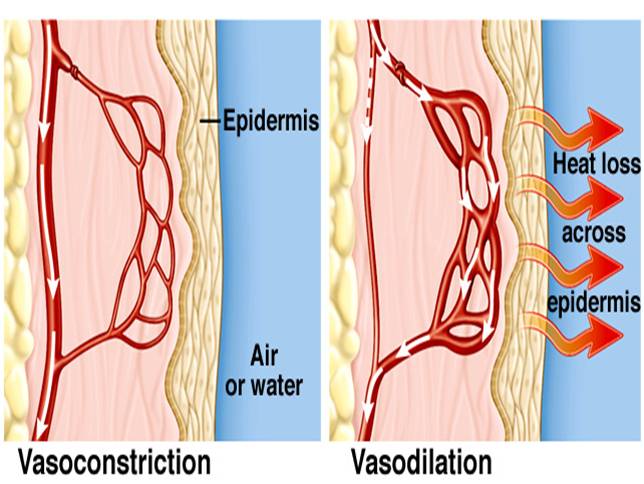2. Short term Adaptation: sweating would be a short term adaptation to heat. Sweat releases heat and cools down the body through evaporative cooling.
Facultative Adaptation: Vasodilatation would be a facultative adaptation
to heat. Swelling of blood vessels increases the amount
of heat carried by the blood to the skin, allowing the excess heat to be
expelled from the body.
Developmental Adaptation: Bipedalism would be a developmental
adaptation to heat. This is an adaptation to efficiently cool the body in hot
temperatures. In a hot places a tall, lean upright posture exposes less surface
area to the sun. It also promotes heat loss by exposing the greatest amount of
surface area to cooling winds and air.
Cultural Adaptation: Air
conditioner would be a cultural adaptation to heat. People using air
conditioner at work, home, cars, malls etc, have found a way to not just beat
the heat, but to prevent the consequences the heat brings with when the body
temperature goes up.
3. The
benefits of studying human variation in this way, is that by observing the
changes in some populations over time, we can evaluate the environmental
stressors that can affect any of them. If we take one population with one
specific trait and move them to another environment, one different than where
they were born, we would see how this group adapts to the new
environment. A good example is studying groups with sickle cell anemia
which is mostly present in black populations, try to find treatments and and
maybe a cure, this will help also other people with sickle cell anemia, not
just the population studied.
4. I
could not use race to understand the variation of the adaptations, because all
humans have the capacity to adapt to new environments, maybe each one will do
it differently, and that would be the interesting part to study. For example,
there could be people that sweat more than others, hence they have more probability
to get dehydrate faster than someone that does not sweat that much.
We already know we all come from a
common ancestor and that our physical differences vary depend on the
environment we live in. I think Is better to study the human variation through
the environmental influences to recognized that race has no genetic basis, and
that we are among the most similar of all species.

Hello!
ReplyDeleteI found your post to be interesting because it differed from my own. Your introduction was informative in identifying an environmental stress that disrupts homeostasis. Excessive heat is most definitely dangerous for the various reasons you have provided. What really helped illustrate the ideas presented were the pictures provided. The image for vasodilation provides a visualization of what is happening with the swelling of blood vessels. Bipedalism appears to be a great developmental adaptation, exposing less surface area to the sun. The section where you explained the benefits of studying human variation is similar to my response. I believe that new evidence is brought on by humans migrating to other environments. I enjoyed reading your conclusion, highlighting the fact that we all come from a common ancestor.
Hi Ana, very interesting post! I also chose heat however did not touch on bipedalism as the developmental adaptation. I think that is a fascinating point and is a great way to directly link this assignment to previous work we've done in this course! Thanks for the informative post.
ReplyDeleteIn general, good discussion on the dangers of heat stress, but recognize the difference between problems directly caused by heat and those indirectly the result of heat stress. For example, dehydration is not the direct result of heat stress. Heat stress is the result of the body trying to adapt to heat stress by sweating, losing body fluids through that stress. Dehydration occurs only because the body tries to adapt to heat stress, not before the body tries to adapt.
ReplyDeleteGood job on your short-term and facultative adaptations.
Heat stress is one argument used to explain the rise of bipedalism, but understand that this in is only hypothetical and has many arguments against it, the key one being, there are many organisms on the African savannah that are subjected to high heat. Why did only humans resort to bipedalism to deal with the heat? More than likely, bipedalism arose for other reasons, but good job raising this point.
Good cultural adaptation.
Yes, it is true that the adaptive approach removed the mystery on sickle cell and it's pattern of expression, helping to explain it and to also help reduce its incidence level. Can you think of examples where similar studies on heat stress might also be practically beneficial? Can knowledge on adaptations to hot climates have medical implications? Help us develop clothing that release heat more efficiently? Can we develop new means of home/building construction that might help decrease heat retention? How can we actually use this information in an applied fashion?
"I think Is better to study the human variation through the environmental influences to recognized that race has no genetic basis"
You are closest to a definitive answer here, but still circling around it. Yes, race has no genetic basis, what does that say about any possible relationship between race and human variation? Race is not based in biology but is a social construct, based in beliefs and preconceptions, and used only to categorize humans into groups based upon external physical features, much like organizing a box of crayons by color. Race does not *cause* adaptations like environmental stress do, and without that causal relationship, you can't use race to explain adaptations. Race has no explanatory value over human variation.between race and human variation?
Ana,
ReplyDeleteGreat post about the effects of heat on humans. Its funny how we experience heat all the time here in southern california, but we never really think about how our bodies are being effected by it. Your details and pictures really helped me understand what heat has done and does to humans.